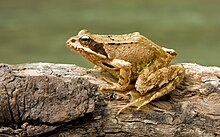Common frog
| Common frog | |
|---|---|
 |
|
| Scientific classification | |
| Kingdom: | Animalia |
| Phylum: | Chordata |
| Class: | Amphibia |
| Order: | Anura |
| Family: | Ranidae |
| Genus: | Rana |
| Species: | R. temporaria |
| Binomial name | |
|
Rana temporaria Linnaeus, 1758 |
|
| Subspecies | |
|
|
 |
|
| Distribution of Rana temporaria in Europe | |
The common frog (Rana temporaria), also known as the European common frog, European common brown frog, or European grass frog, is a semi-aquatic amphibian of the family Ranidae, found throughout much of Europe as far north as Scandinavia and as far east as the Urals, except for most of Iberia, southern Italy, and the southern Balkans. The farthest west it can be found is Ireland, where it has long been thought, erroneously, to be an entirely introduced species. They are also found in Asia, and eastward to Japan.
Common frogs metamorphose through three distinct developmental life stages — aquatic larva, terrestrial juvenile, and adult. They have corpulent bodies with a rounded snout, webbed feet and long hind legs adapted for swimming in water and hopping on land. Common frogs are often confused with the common toad Bufo bufo, but frogs can easily be distinguished as they have longer legs, hop, and have a moist skin, whereas toads crawl and have a dry 'warty' skin. The spawn of the two species also differs in that frogspawn is laid in clumps and toadspawn is laid in long strings.
The adult common frog has a body length of 6 to 9 centimetres (2.4 to 3.5 in) its back and flanks varying in colour from olive green to grey-brown, brown, olive brown, grey, yellowish and rufous. However, it can lighten and darken its skin to match its surroundings. Some individuals have more unusual colouration — both black and red individuals have been found in Scotland, and albino frogs have been found with yellow skin and red eyes. During the mating season the male common frog tends to turn greyish-blue (see video below). The average weight is 22.7 g (0.80 oz); the female is usually slightly larger than the male.
The flanks, limbs and backs are covered with irregular dark blotches and they usually sport a chevron-shaped spot on the back of their neck and a dark spot behind the eye. Unlike other amphibians, common frogs generally lack a mid-dorsal band but, when they have one, it is comparatively faint. In many countries moor frogs have a light dorsal band which easily distinguishes them from common frogs. The underbelly is white or yellow (occasionally more orange in females) and can be speckled with brown or orange. The eyes are brown with transparent horizontal pupils, and they have transparent inner eyelids to protect the eyes while underwater, as well as a 'mask' which covers the eyes and eardrums. Although the common frog has long hind legs compared to the common toad, they are shorter than those of the agile frog with which it shares some of its range. The longer hind legs and fainter colouration of the agile frog are the main features that distinguish the two species.
...
Wikipedia

